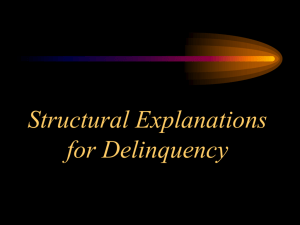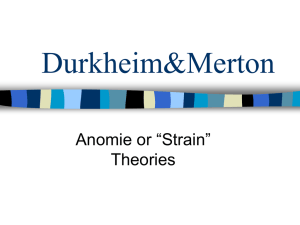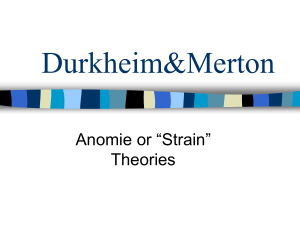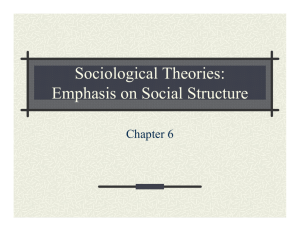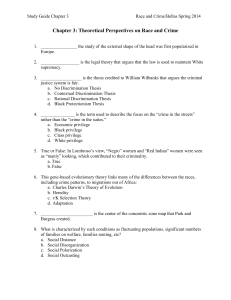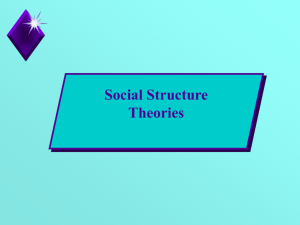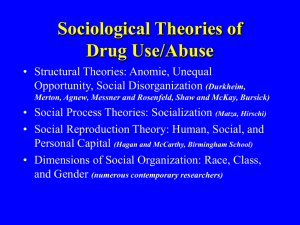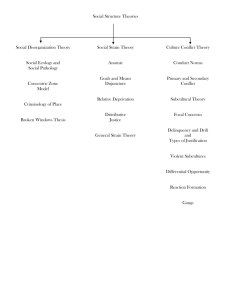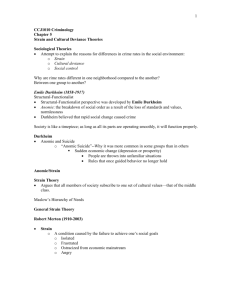CRIM_-_Lesson_6_-_Social_Structure_Theories 452.2 KB
advertisement
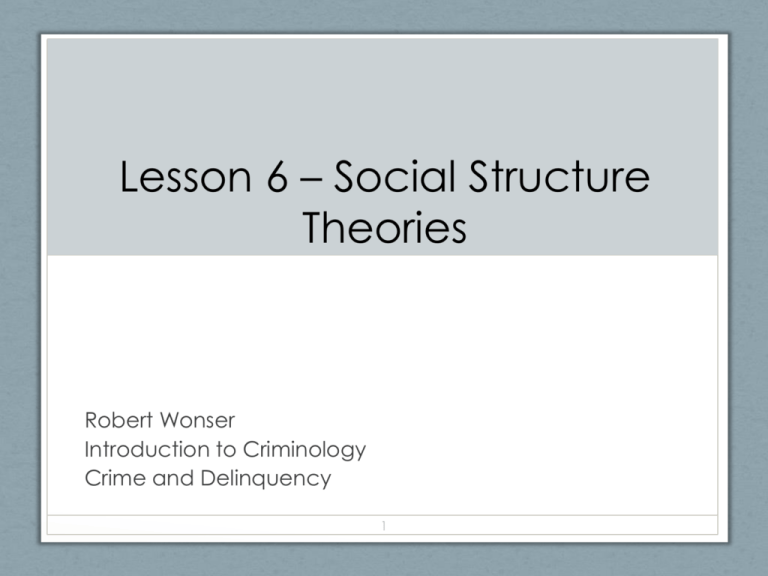
Lesson 6 – Social Structure Theories Robert Wonser Introduction to Criminology Crime and Delinquency 1 Introduction • Individual-level theories cannot easily account for crime • Social structure (environment) • Evaluates why some locations and groups have higher crime rates 2 The Legacy of Durkheim • Durkheim emphasized the importance of structure • Impulses held in check by • Socialization • Social ties • Social norms 3 Durkheim • Anomie, normlessness • Periods of rapid social change • Norms become less applicable • Lead to higher suicide rates • Low social integration 4 Social Disorganization and Human Ecology • Society changing in the 1800s • Move from rural to urban areas • Changing nature of relationships • Social pathology, those human actions which ran contrary to ideals of residential stability, property ownership, sobriety, thrift, habituation to work, small business enterprise, sexual discretion, family solidarity, neighborliness and discipline of the will. 5 Chicago School of Sociology • Chicago used as a laboratory • W.I. Thomas and Florian Znaniecki • Social disorganization • Robert E. Park and Ernest W. Burgess • Human ecology - study of the relationship between humans and their natural, social, and built environments. • Concentric zones 6 Clifford R. Shaw and Henry D. McKay • Studied crime in Chicago from 1900-1933 • Delinquency high in inner zones of city regardless of which immigrant group or minority lived there • Delinquency decreased as one moved away from the inner city 7 Inner City Explanations • Social disorganization created a climate where: • Informal social control was weak • Deviant values emerged • Adolescents grow up among conflicting values • Higher crime rates not due to biology or psychology 8 Evaluating Social Disorganization • Popular theory • Had numerous methodological problems • Use of official records • Circular reasoning • Focus on poor criminals • Underestimates of social organization 9 Social Disorganization Revival • Mid-1980s • Recent research uses victimization and survey data • Focus on: • Collective efficacy defined as social cohesion among neighbors combined with their willingness to intervene on behalf of the common good, is linked to reduced violence. • This hypothesis was tested on a 1995 survey of 8782 residents of 343 neighborhoods in Chicago, Illinois. Multilevel analyses showed that a measure of collective efficacy yields a high between-neighborhood reliability and is negatively associated with variations in violence. • Residential mobility 10 Other Ecological Work • Extreme poverty • Economic deprivation • Concentrated disadvantage • Relative deprivation • Theory of deviant places • It’s not “kinds of people” but “kinds of places” • Neighborhood density 11 Anomie/Strain Theory • Based on work of Durkheim, Robert K. Merton • A lack of harmony (anomie) between goals and means results when too much emphasis is place on goals and/or means • In America, too much emphasis on goal of economic success • American Dream • This emphasis results in criminality when the means are lacking • Based on inability to attain societal goals, people choose a mode of adaptation 12 Modes of Adaptations 13 Evaluating Anomie/Strain Theory • Questions about emphasis on poor • Does not explain violent crime • The role of thrill seeking • Ignores link of alcohol/drugs • Fails to explain one adaptation over another 14 Institutional Anomie Theory • To achieve the American dream, people eagerly pursue economic success • Key values • Achievement • Individualism • Strain concepts focus on difference between • Educational aspirations • Occupational aspirations 15 Economic Dominance, the “American Dream,” and Homicide: A Cross-National Test of Institutional Anomie Theory • A cross-national study finds that homicide is more common in countries that valorize the free market, emphasize individual achievement, and fetishize money. • While none of the theoretical predictors exhibits a statistically significant direct effect on homicide, findings suggest that homicide occurs most often in countries where free-market principles and practices drive the economy and where core cultural commitments are oriented toward achievement, individualism, fetishism of money, and universalism. • Mixed results provide only limited evidence in support of the American exceptionalism thesis. 16 General Strain Theory • Robert Agnew • Adolescent strain results not only from failure to achieve economic goals, but from failure to achieve noneconomic goals • For example: destructive social relationships • Negative affect states (anger) 17 Subcultural Theories • Albert K. Cohen • School Failure and delinquent subcultures • Focus on lower-class boys • Focus on thrills • As such, delinquency does not stem from anomie 18 Delinquent Subcultures • Cohen kept Merton’s conception of strain • Goals involve making favorable impression on others and self-esteem • The school experience of lower-class boys makes it difficult to achieve these goals 19 Delinquent Subcultures • Status frustration • Strain • Hedonism • Maliciousness 20 Evaluating Cohen’s Status Frustration Theory • Emphasis on males • New focus on gang research • Only emphasized lower-class crime • Linkage between schools and crime • Failure to explain why some poor students do not become delinquent 21 • Victor Rios’ youth control complex argues that the punishing arm of the state (the prison system) and the nurturing arm of the state (the education system) work together to criminalize, stigmatize, and punish young inner city boys and men. • Reduce boys’ criminal involvement? Get a romantic interest, for girls, it’s the opposite. 22 Focal Concerns • Walter B. Miller • Focus on lower-class subculture • The focal concerns of these children: • Trouble • Toughness • Smartness • Excitement • Fate • Autonomy 23 Evaluating Focal Concerns • Received withering criticism • Ignoring effect of economic deprivation • Emphasis on blaming the victim • Similarity of values between poor and middle-class • Circular reasoning 24 Differential Opportunity Theory • Richard Cloward and Lloyd Ohlin • Anomie/strain failed to account for selection of adaptive roles • Cloward an Ohlin suggested differential access to illegitimate mean • Illegitimate opportunity structure • Based on neighborhoods 25 Differential Opportunity • Neighborhood deviant activities effect • Social organization • Types of subculture • Criminal • Conflict • Retreatist 26 Evaluation of Differential Opportunity • Popular • Prompted anti-poverty programs in the 1960s • Gang specialization debunked • Neglected • Middle-class values • White-collar crime 27 Subculture of Violence • Marvin Wolfgang and Franco Ferracuti • Explains high level of violence among poor, urban males • Resorting to violence/aggression is socially approved to deal with certain stimuli 28 Evaluating the Subculture of Violence • Very controversial • Findings across demographic subgroups • Race • Urban areas • Circular reasoning • Growing body of research supports basic theme with more emphasis on structure 29 The Code of the Street • Elijah Anderson • Code emerges from young, urban, African-Americans’ despair and alienation • “At the heart of the code is the issue of respect--loosely defined as being treated "right," or granted the deference one deserves.” • “This hard reality can be traced to the profound sense of alienation from mainstream society and its institutions felt by many poor inner-city black people, particularly the young. The code of the streets is actually a cultural adaptation to a profound lack of faith in the police and the judicial system.” 30 Structural Theories and Gender • Gender rarely studied in structural theories • Males are the primary focus • Economic marginality hypothesis • Few subcultural areas that focus on females 31
